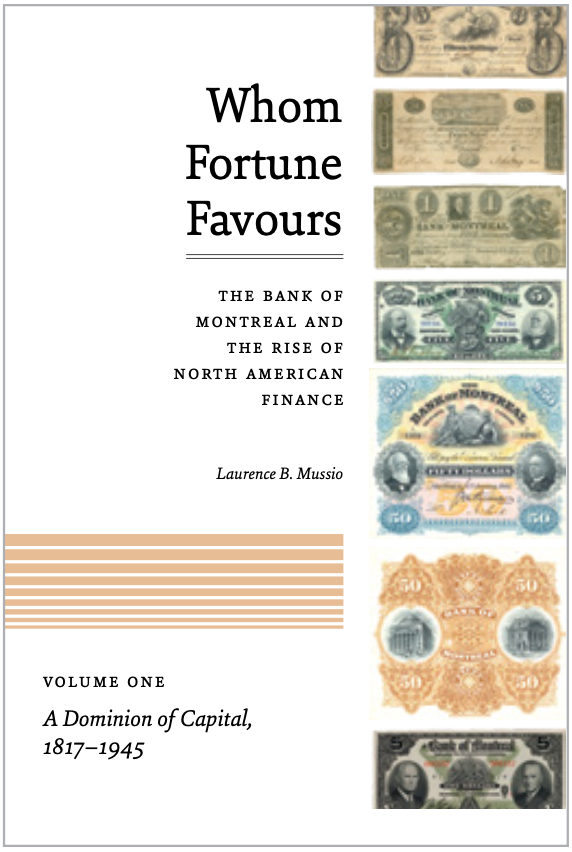A Blue-Chip Investment

Laurence B. Mussio, with foreword by Niall Ferguson
Whom Fortune Favours: The Bank of Montreal and the Rise of North American Finance. Montreal and Kingston: McGill-Queen’s University Press, 2020.
Volume 1–A Dominion of Capital 1817-1945
Volume 2–Territories of Transformation 1946-2017
Review by James Baxter
Historian Laurence Mussio’s latest work, Whom Fortune Favours, is not for everyone. Indeed, one must be passionate about banking or Canadian history—ideally both—to want to devour the roughly 600 pages contained in this two-volume set. But for those who are so passionate, Whom Fortune Favours is a richly rewarding experience.
Before going further, it is worth noting that this book is visually stunning, elegantly packaged and filled with wonderful old photos and illustrations from the first 200 years of the Bank of Montreal. From the colourful banknotes on the cover to the drawings of founders John Richardson and Augustin Cuvillier in 1817, to the news photos of the BMO’s failed merger with the Royal Bank of Canada in the late 1990s, Mussio offers a brilliantly curated visual history of Canada’s first major bank and the outsized role it played in the birth of this country.
Mussio’s accessible writing style turns the relatively dry topics of banking and finance into a ripping yarn that spans 10 generations of underexplored Canadian history. It is clear from the narrative that the book is based on thousands of hours of research and troves of documents and letters from the times when clear, succinct writing was valued.
It is this research that drives Volume One, which covers the bank’s history from its first charter in 1817 through to the end of the Second World War in 1945. Mussio easily weaves the chronology and the many personalities who served as officers and directors to show how the Canada we know today would be fundamentally different had it not been for BMO and the men who built it. Names like McGill, Gray, Gates, Gerrard, Fleming and Molson are synonymous with the era in which BMO garnered much of its “reputational capital” and gave Montreal its status as an economic powerhouse in the new world.
The mid-1800s were a fascinating time as Loyalists fled the United States and the waves of European immigrants arrived to find their fortunes, and Mussio details how BMO played a pivotal role in the development of Lower Canada and the expansion westward.
Of course, with growth comes competitors and BMO had many. From 1850 to 1925, dozens of banks came and went, but eventually, the most successful of these came together in the wake of the revised Bank Act in 1901. By 1925, BMO was among the strongest banks in North America, which proved critical to its ability to weather the ravages of the Great Depression and help lead Canada into the Second World War, then into its second century as a country.
In capping this early period, Mussio devotes a chapter to the creation of the Bank of Canada in 1935 and how it enabled the ascension of Canadian banking to the global stage.

With Volume 2, Mussio transitions from the bank’s ancient history to its living history, which led to both the BMO and the country we know today. Whereas his account of the bank’s first century seemed largely to jump from strength to strength, Mussio’s coverage of the post-war era is able to draw on more contemporary records and interviews to detail the bank’s successes and failures, as well as its triumphs and struggles through numerous periods of national and international upheaval.
Niall Ferguson provided the foreword to the book and took the opportunity to show how BMO’s Scottish founders instilled a cautious but deliberate culture that served the company very well for most of its history. Indeed, it was only when the bank’s leadership deviated from its inherent conservativeness that big mistakes happen (remember “mbanx”). Ferguson clearly enjoyed Mussio’s book and the tale it tells about how his countrymen conquered the new frontier one bank branch at a time.
At almost $80 and more than 600 pages of tight prose, Whom Fortune Favours is an investment in many ways. But for anyone with a strong appreciation of North American economic history, this book will be a blue-chip addition to any library.
Contributing Writer James Baxter is a veteran journalist with deep ties to Montreal and the bank that bears its name. He was the founding Editor and Publisher of iPolitics.
